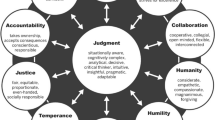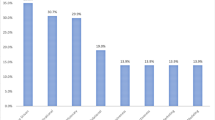Abstract
Research has consistently found that effective leadership is perceived as characterized by traits similar to those associated with masculine gender roles. These perceptions would appear to be at odds with extensive research indicating that effective leadership requires “consideration” and “structuring” behaviors—behaviors that seem to represent both masculine and feminine styles. In two separate studies, the correspondence between gender stereotypes and dimensions of effective leadership were assessed. Results indicate that consideration behaviors are perceived to be feminine, while structuring behaviors are perceived to be masculine. Similarly, qualities that characterize the masculine gender role are perceived to be consistent with structuring, while qualities associated with the feminine gender roles are perceived to be consistent with consideration. It is suggested that an increased awareness of the “androgynous” nature of effective leadership behaviors might weaken the biases in favor of male leaders.
Similar content being viewed by others
References
Bem, S. L. (1974). The measurement of psychological androgyny. Journal of Consulting and Clinical Psychology, 42, 155–162.
Blake, R. R., & Mouton, J. S. (1978). The new managerial grid. Houston: Gulf.
Brenner, O. C., Tomkiewicz, J., & Schein, V. E. (1989). The relationship between sex role stereotypes and requisite management characteristics revisited. Academy of Management Journal 32, 662–669.
Brown, S. M. (1979). Male versus female leaders: A comparison of empirical studies. Sex Roles, 5, 595–611.
Cann, A., & Siegfried, W. D. (1987). Sex stereotypes and the leadership role. Sex Roles, 17, 401–408.
Dobbins, G. H., & Platz, S. J. (1986). Sex differences in leadership: How real are they? Academy of Management Journal, 11, 118–127.
Fleishman, E. A. (1973). Twenty years of consideration and structure. In E. A. Fleishman & J. G. Hunt (Eds.), Current developments in the study of leadership. Carbondale: Southern Illinois University Press.
Landy, F. J. (1989). Psychology of work behavior. Pacific Grove, CA: Brooks-Cole.
Powell, G. N. (1988). Women and men in management. Newbury Park, CA: Sage.
Powell, G. N., & Butterfield, D. A. (1979). The “good manager”: Masculine or androgynous? Academy of Management Journal, 22, 395–403.
Powell, G. N., & Butterfield, D. A. (1984). If “good managers” are masculine, what are “bad managers”? Sex Roles, 10, 477–484.
Powell, G. N., & Butterfield, D. A. (1989). The “good manager”: Did androgyny fare better in the 1980's? Group and Organization Studies, 14, 216–233.
Rice, R. W., Instone, D., & Adams, J. (1984). Leader sex, leader success, and leadership process: Two field studies. Journal of Applied Psychology, 69, 12–31.
Schein, V. E. (1973). The relationship between sex role stereotypes and requisite management characteristics. Journal of Applied Psychology, 57, 95–100.
Schein, V. E. (1975). The relationship between sex role stereotypes and requisite management characteristics among female managers. Journal of Applied Psychology, 60, 340–344.
Spence, J. T., & Helmreich, R. L. (1978). Masculinity and femininity: Their psychological dimensions, correlates, and antecedents. Austin: University of Texas Press.
Trempe, J., Rigny, A., & Haccoun, R. (1985). Subordinate satisfaction with male and female managers: Role of perceived supervisory influence. Journal of Applied Psychology, 70, 44–47.
Williams, J. E., & Bennett, S. M. (1975). The definition of sex stereotypes via the adjective checklist. Sex Roles, 1 327–337.
Williams, J. E., & Best, D. L. (1982). Measuring sex stereotypes: A thirty nation study. Beverly Hills, CA: Sage.
Author information
Authors and Affiliations
Rights and permissions
About this article
Cite this article
Cann, A., Siegfried, W.D. Gender stereotypes and dimensions of effective leader behavior. Sex Roles 23, 413–419 (1990). https://doi.org/10.1007/BF00289229
Issue Date:
DOI: https://doi.org/10.1007/BF00289229




